So it's the version that doesn't exist then
 I'm confused breh it comes out Tuesday
I'm confused breh it comes out TuesdaySo it's the version that doesn't exist then
 I'm confused breh it comes out Tuesday
I'm confused breh it comes out TuesdayI'm confused breh it comes out Tuesday
Got rid of almost all my remaining DVDs last night. did a few disc to digitals to vudu for $2 each with the trick and cleared tons of shelf space.
Added Traffic, Toy Story 3 and The Usual suspects blus for $17 total.
what trick is this you speak of? and can you expand more about this process?...is it like saving all your movies on a HD or cloud?....
@satam55 can expand on it he gave it to be but I lost it and just do it trial and error now.
Basically you take dvd's and put em in your VUDU cloud with the vudu2go at home program
The Original Series, The Next Generation and Enterprise are all available in high-definition on Blu-ray and streaming services. So, when will Deep Space Nine and Voyager be available in superior quality?
That’s a question we receive here at TrekNews.net on a regular basis. I’m talking every… single… time… we post something about either of those two shows, we inevitably get inundated with questions about it or receive tweets from readers asking why CBS is re-releasing both series on DVD, as opposed to on Blu-ray.
I get it. Believe me, I do. I’d LOVE to see both of those shows in HD. Could you imagine how great “It’s Only a Paper Moon” or “Endgame” would look in crisp high-def? I get excited just thinking about it. And I know many of you do, as well.
So, why aren’t these incredible shows getting the same treatment as the others? I recently reached out to the writer, director, producer and editor of the incredible bonus features found on The Next Generation and Enterprise Blu-ray sets, Robert Meyer Burnett, to get some answers. Burnett was so heavily involved on the previous remastering projects, he seemed like the perfect source for answers to my burning questions.
If you’ve ever wondered about Deep Space Nine and Voyager on Blu-ray, sit back and relax as Burnett provides an enormous amount of detailed information that will most likely answer all of them.
TrekNews.Net: Over the course of the next few weeks, we’ll see CBS release complete series sets of both Star Trek: Deep Space Nine and Star Trek: Voyager on DVD. With the remastering of Star Trek: The Next Generation and Star Trek: The Original Series now complete, why do you think CBS made the decision not to do the same with those shows at this time?
Robert Meyer Burnett: A complicated question with a simple answer; It takes way too much time and money to remaster DS9 and Voyager into HD.
But I have a longer and hopefully more comprehensive answer for you. Because even after eight years since The Original Series Blu-rays hit, there’s still a great deal of misunderstanding regarding the restoration of both TOS and TNG.
Until fairly recently, both motion pictures and TV were shot mostly on 35mm film — live television, news, talk shows, game shows, soap operas etc., were shot on various video formats, and the difference from film was readily apparent. Some television used 16mm while certain event films were shot on 65mm, but for the most part, 35mm film was the industry standard.
35mm film has resolution of about 20 megapixels or greater. Comparatively, NTSC video, used in North America and Asia, has basically 640 pixels by 480 scan lines of resolution… far, far, FAR less than the resolution of 35mm film.
Both motion pictures and TV used to be finished the same way. After being shot on film, that film was edited, the negative was cut and prints were struck from that cut negative. All visual effects, titling, etc., were also shot on film. Depending on the finishing process, the resolution of the 35mm film was retained in the cut negative. This cut negative, properly stored and cared for, was then put away until it was needed to either strike new prints, or be scanned for use on television and home video.
It was the dark times, before the rise of HD and now UHD images, ALL movies and television originating on film were scanned down to standard definition video resolution from their original negatives. NTSC resolution in North American and Asia. So a 20 megapixel original image was scanned down to 640 pixel x 480 line image, so we could all watch them on broadcast television, and later VHS and DVD. For over 50 years, the images we all saw on TV were really quite terrible, displaying a mere small fraction of the color and clarity contained in the original 35mm camera negatives.
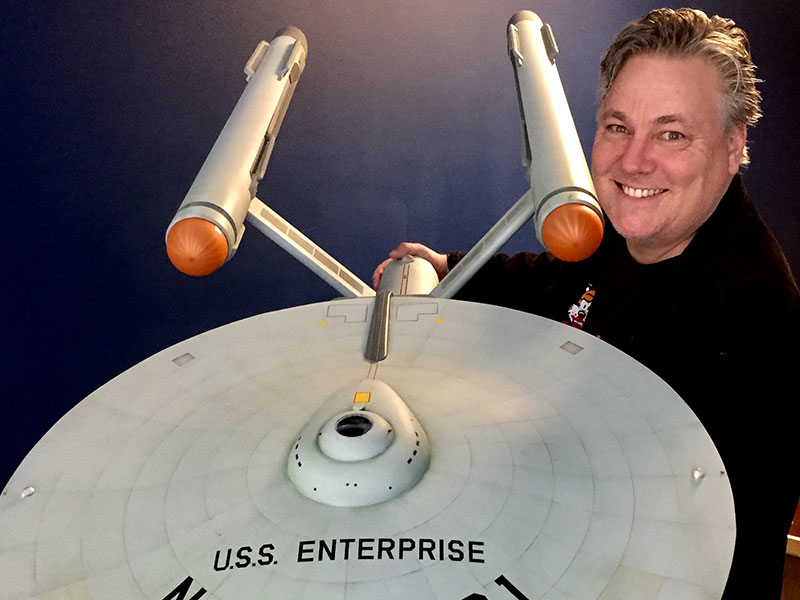
Burnett holding the Enterprise model constructed by Greg Jein for the Deep Space Nine episode “Trials and Tribble-ations”
But most people didn’t know this. Or even care. Television was television, movies were movies and of course movies looked way better when you went to the theater.
Here’s where it gets both interesting and maddening. In the mid-1980s, the advent of cheaper and cheaper computing technology allowed video post-production to grow more and more sophisticated. Now, a new post-production methodology, once existing only for shows originating on videotape, like soap operas and talk shows, could now be applied to shows shot originally on film. A program could be shot on 35mm film, but instead of editing on film and then cutting negative, the original 35mm material footage would instead be scanned to videotape — at NTSC resolution, and the rest of the post-production process, editing, mixing, etc., would then be completed on tape, at a reduced cost. However, NO FILM NEGATIVE WAS CUT, so the final product would only exist on videotape, at NTSC’s greatly reduced video resolution and color. True blacks, stable reds and rich blues simply didn’t exist on videotape. Those shows originally shot on 35mm, with a 20 megapixel resolution, were never to be seen again if finished on tape.
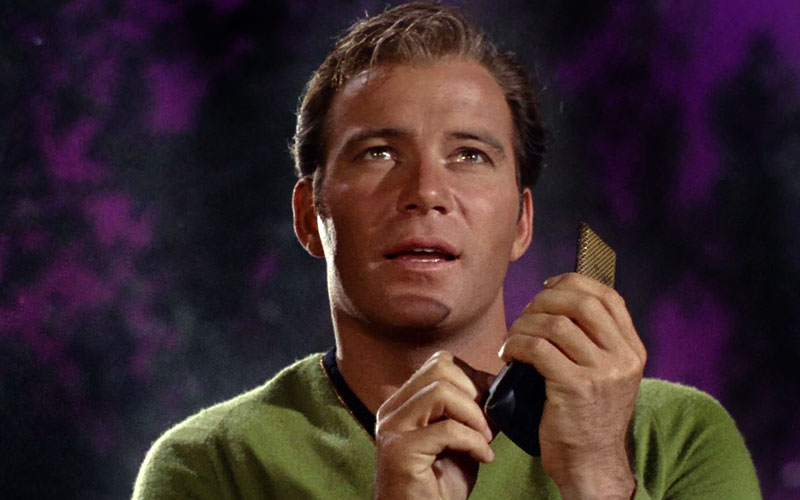
Star Trek: The Original Series, Season 2, Episode 4 “Mirror, Mirror”
For certain programing, such as science fiction television, the upside of this new post process allowed certain VFX elements to be produced far, far cheaper for television than ever before. For instance, a phaser blast or energy field, once hand-animated and shot on film, could now be generated and animated by some kind of video toaster technology at far less cost, in a much shorter time. Once, a producer might only be able to afford two phaser beams, but now they might now get themselves seven or eight blasts, allowing a much more exciting firefight. For the discerning viewer however, this combination of film and video imagery, especially in genre programming, didn’t look very convincing, barely a step up from Land of the Lost.
The mid-80s Twilight Zone revival, as much as I adore it, is a perfect example of the incongruity of 35mm live-action photography and NTSC video generated special FX. But again, most viewers couldn’t tell the difference.
In late 1986 and early 1987, during the development of Star Trek: The Next Generation, it was decided early on the only way to produce the series on time and on budget, with all of the VFX demands Trek required, would be to shoot on 35mm film, then finish on videotape. Even the motion control model photography, with all of the individual passes required, would be shot on 35mm and then, in an unprecedented move, actually composited on videotape using multiple, daisy-chained VTRs to minimize the reduction of resolution even further.

Star Trek: The Next Generation, Season 4, Episode 26 “Redemption”
Unfortunately, this meant, unlike TOS and The Animated Series, there would be no 35mm finished negative of TNG… and the series would only ever exist on videotape at NTSC resolution. The same would hold true of DS9 and Voyager. Enterprise though, shot in 2001, would be future-proofed, shot on 35MM and finished in HD, with the VFX created in CG at 720p, until the fourth season, which abandoned film altogether.
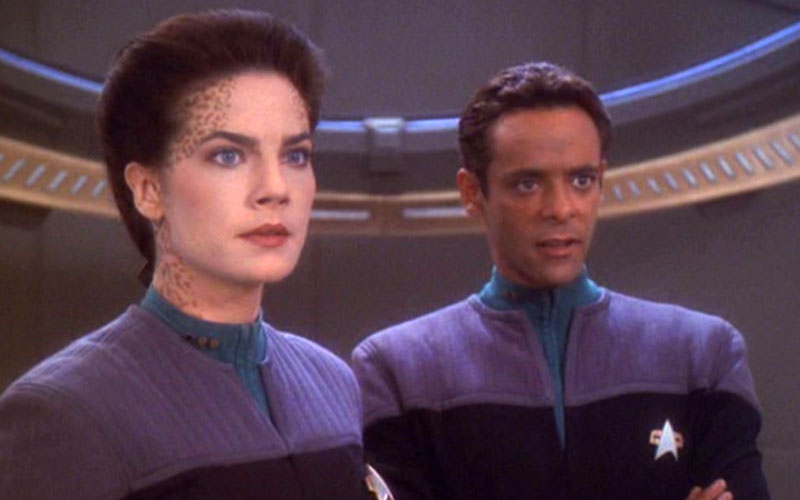
Star Trek: Deep Space Nine, Season 6, Episode 11 “Waltz”
Starting in 2004, after the beginning of regular HD broadcasts, it quickly became apparent to anyone paying attention, standard resolution, NTSC video would soon be rendered obsolete. After seeing an HD image, who would ever want to watch standard definition video again? Studios quickly began transferring their films and television to High Definition formats, settling, until very recently, on 1080p as the industry standard, bringing up pixel dimensions to 1920×1080, roughly five times the definition of standard definition video.
For TOS and The Animated Series, the transfer into High Definition was not problem. Each episode of TOS and The Animated Series already exists as a single cut negative, so he transfer process the same as any other film or television episode with cut negative.
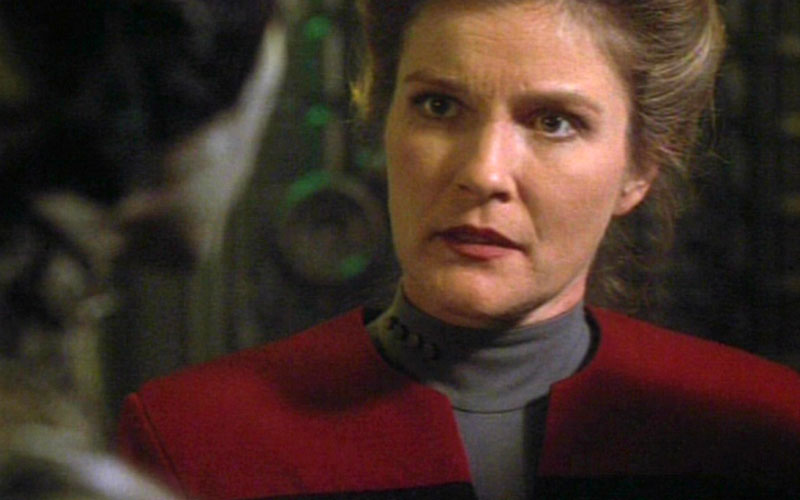
Star Trek: Voyager, Season 4, Episode 1 “Scorpion, Part 2”
Then why does the remaster of TOS have new VFX? A few reasons, actually. Originally, optical compositing was used to create spaceship shots, with many pieces of film combined and reshot on an optical printer. This process was used since the beginning of motion pictures, but each separate film element used multiple stocks and dirt tended to build up during the mechanical process of optical printing. Butted up next to the beautiful, live-action TOS footage, the original VFX, with its added dirt and diminished resolution, looked incongruous. So, CBS decided to create NEW visual effects which would smoothly transition with the stunningly colorful, live-action photography. The new VFX created a seamless experience and, as an added benefit, updated what some see as the most dated element of the original show. Thankfully, in a wise move, CBS included both versions on their blu release.

Star Trek: Enterprise, Season 4, Episode 1 “Storm Front”
But TNG, DS9 and Voyager could not be rescanned and released in Full HD, as the original edited programs only existed on tape at NTSC resolution. With worldwide markets rapidly converting to HD, modern Trek, with the exception of Enterprise, would simply no longer be shown anywhere. With TNG still the most successful Trek series by a wide margin, Paramount and CBS desperately wanted to figure out a way to not let their crown jewel get thrown onto the scrapheap of history. Something had to be done.
So a radical notion was proposed…why not go back to the original negative and REBUILD the entire show, from from the ground up, in High Definition? In the history of television, this had never been done before. Essentially, all 178 episodes of TNG (176 if you’re watching the original versions of “Encounter at Farpoint” and “All Good Things”) would have to go through the entire post-production process AGAIN. The original edits would be adhered to exactly, but all the original negative would have to be rescanned, the VFX re-composed, the footage re-color-timed, certain VFX, such as phaser blasts and energy fields, recreated in CG, and the entire soundtrack, originally only finished in 2 channel stereo, would be remastered into thunderous, 7.1 DTS.
A Herculan task, to be sure, requiring many people working full time for years, to the tune of somewhere north of twelve million dollars. The enormous sweat-equity involved required the stamina of a long-distance runner. First, ALL the original negative would have to be tracked down, which was stored in thousands of boxes, then matched to every scene and take from the original finished episodes. Then, all of that negative needed to be scanned at 2K and color-timed from scratch, as the entire color palate of the series would change. For the first time, the REAL colors could be seen. For the model photography, also completed in 35mm, an added headache was discovered; celluloid sometimes shrinks over 25 years, so many VFX passes, requiring pin-registered accuracy with sometimes over ten elements to composite wouldn’t match up, so they had to be first scanned then recomposited in the computer. While that was the plan all along, sometimes certain elements were either lost, or just too damaged to use, so an entire shot would have to be recreated in CG. Then, any phasers or other effects created utilizing the orignal technology of the era would have to then be recreated using modern CG. This created an interesting artistic dilemma for the restoration team…re-design something to update the look, or, whenever possible, use CG to recreate something to appear as close to the original intent, by the original production team, as possible. They chose the latter (the Crystalline Entity from first season’s “Datalore” is a great example of this).

The Crystalline Entity from TNG-Remastered “Datalore”
Long discussions were had about whether or not to finally go back and fix things, such as the scale issue of the various classes of Klingon Birds of Prey, but it was decided not to make such changes, and allow the show to exist as it always had. This was a philosophically different approach the TOS restoration, which did update and modernize certain elements, to clarify or expand the storytelling. So with TNG, the long debate about whether or not the Enterprise D could actually fit inside the space dock from “11001001” will continue to rage in backgrounder circles.
From 2012 through 2014, the seven seasons of TNG, along with 5 single discs (two-part episodes cut into feature presentations) were released on Blu-Ray, with over 50 hours of newly-produced special features. The restoration remains an absolutely astonishing achievement in the annals of television and anyone watching the new versions of the episodes, can only marvel at the vast difference from the originals. Everyone involved at CBS Digital and the various other Post Houses who participated in the project deserve a hearty round of applause from fans the world over. At least the fans who appreciate and understand just how much work was done.
Unfortunately, during this same time, the popularity of streaming services skyrocketed, and popularity of physical media began to diminish. Sales of physical discs dropped 10% a year across the board, the younger generation thought putting discs in machines was too 20th Century and even the loyal Trek fan base asked themselves, “why do I have to buy TNG YET AGAIN?” I bought the VHS tapes, the Laserdiscs and the DVDs, so do I really need the Blu-rays…? I don’t even have a Blu-ray player. Won’t it all be on Netflix anyway?” The absolutely justified high price-point of the initial Blu-ray seasons also didn’t help sales.
Ultimately, the final result of all the effort put into the restoration itself and the newly-created special features were ultimately disappointing. The disc sales didn’t match projections and continued to suffer as more and more people turned to streaming, where Star Trek was already widely available. Sure, the newly-remastered episodes of TNG have quietly replaced the original versions, but nowadays, very few people even notice, as they expect HD to look great.
Both Deep Space Nine and Voyager would require at least the same amount of time, manpower and money, but neither show was ever as popular as TNG or TOS. So, how can CBS be expected to shell out probably 20-million dollars per series to remaster them into HD?
TrekNews.net: Would remastering DS9 and Voyager be more difficult than the TOS and TNG projects were? If so, could you explain?
Robert Meyer Burnett: They absolutely would. Unlike TNG, which shot both all of their live-action and all of their model photography on 35mm film, which made scanning the original elements possible, both DS9 and Voyager made extensive use of CGI for their visual effects, especially in the later seasons. Those visual effects were rendered in standard NTSC resolution, with a maximum of 525 scan lines of resolution per second, split between two interlaced video fields of 262.5 scan lines running at 60 fields per second. So, the original resolution remains far, far below what audiences used to today’s HD, and now UHD resolutions, are accustomed to. These VFX could be upscaled 5x, but they’d have no detail. The Starship Defiant would look like a fuzzy, grey blob.
If the VFX assets originally created for the shows could be acquired, which is a HUGE if, they could be reworked and re-rerendered in 2K resolution for Blu-ray, but even then, VFX artists would have to go in and add all kinds of upgrades to the original shots to make the ships, planets, weapons fire and explosions. look like they fit in with the gorgeous live-action photography. This would entail a number of artists working many, many long hours at considerable expense.
During the latter seasons of the TNG restoration, Mojo, one of the original, Emmy-Winning VFX artists on Voyager, who, at the time, was still in possession of many of the original DS9 and Voyager VFX assets, did a re-rendering VFX test on footage from “The Sacrifice of Angels.” The test really looked spectacular, and proved it could be done. But again, it would still take very talented VFX artists working long hours to accomplish the number of shots required for the episodes at great cost.
However, since then, I’ve heard many of these assets have been lost, either through drive failure, or simply the dumping of all the original data.
The only alternative would be to re-create all of the CG VFX shots from scratch, much the same way CBS Digital re-created TOS’ visual effects. But with the number of elements needed during DS9’s Dominion War arc, with sometimes hundreds of starships in combat, this could cost in the millions, if not tens of millions of dollars, depending on who was doing the VFX.
TrekNews.net: Do you think CBS All Access could be the impetus for CBS to remaster those shows?
Robert Meyer Burnett: Hard to say, but probably no. Like Amazon and Netflix have already discovered, the success of All Access depends on whether or not there’s enough exclusive content to convince viewers to sign up. Star Trek: Discovery is a good start, but it remains to be seen if it can not only recapture the fanbase, but also be destination viewing for an entirely new audience. But until All Access has Netflix money to burn, there’s not going to be a DS9 or Voyager restoration anytime soon. Again, you’re looking at eight years and perhaps 40 million dollars of work.
TrekNews.net: Are you aware of any newly recorded bonus material that will appear on the new DS9 and Voyager DVD sets?
Robert Meyer Burnett: With the meteoric rise of streaming services like Netflix, Hulu and Amazon, and the inevitable steady decline of physical media, the studios are spending very little money on special features these days. Warner Home Video even returned to static disc menus, not seen since the early days of the DVD format, to keep budgets down. For a special features auteurist such as myself, it’s very disheartening. Fortunately, boutique companies like SHOUT Factory, Arrow and Criterion are keeping the art alive, but at substantially reduced budgets. Flying up to Calgary to do a live, multi-camera shoot with the entire cast of TNG, as we did, is certainly a thing of the past. Thankfully, you can see me host this amazing reunion on the TNG – Season Two Blu-ray set.
For the TNG Remastering project, both Roger Lay Jr. and I, and Star Trek fans everywhere, were extremely lucky to have Ken Ross, the Executive Vice President and General Manager of CBS Home Entertainment, overseeing the entire restoration, including all of our special features. A huge proponent of the TNG project from the very beginning, he not only convinced CBS such a restoration was possible, but essential. Ken shook loose the millions of dollars needed to restore all 178 episodes of TNG. He was also personally responsible for securing the involvement of all of the principal cast for our special features. Ken is a legend in the home video business, beginning his career just out of college in the early 80s, working for Andre Blay’s Magnetic Video, one of the very first home video companies ever, eventually acquired by 20th Century Fox and becoming CBS/FOX Home Entertainment.
Also, because Roger and I were such fanatical Trek fans, we delivered far, far more special features than we ever contracted to produce. We just thought up cool pieces and produced them, such as the writer’s roundtable on the TNG Season Three set. For instance, because we knew he was such a fanatical TNG fan, we thought Seth MacFarlane would be perfect to host the roundtable. We asked Brannon Braga, at the time working with Seth on Cosmos, if he might host and to put in a good word for us. Brannon said “sure,” so one day, Roger just called up Seth and asked him to host the roundtable, and he agreed. We certainly couldn’t pay him for his services, but because he loved Trek, not only showed up, but arrived with pages and pages of hand-written research notes and delivered a rollicking conversation with the TNG writing staff which has since been ripped off for other shows many times since. For our Enterprise cast reunion, we basically shot the entire 90 minute piece for free, the actors agreeing to participate simply because Brannon Braga was involved and they’d loved the show. As an aside, I think Bacula agreed because he wanted to give Brannon shyt for the series finale of Enterprise.
Unfortunately, the TNG Blu-rays, after a promising start, simply didn’t sell as well as expected, and the expense of producing such an amazing restoration wasn’t as immediately profitable as first hoped. Neither the unprecedented restoration, or our extensive special features, enticed enough of the fanbase to double, or even, in some cases, triple-dip — which is a shame, because I can honestly say the TNG Blu-rays, along with The Twilight Zone Blu-rays, remain the two greatest television releases of the home video era.
After the wonderful recent Original Series feature releases and the Roddenberry Vault, with special features also produced by Roger Lay Jr. and the Okudas, I expect we won’t see such special features on future Trek releases, with perhaps Star Trek: Discovery being an exception. I know there was a short list of very capable special feature producers for the production, and any one of them could produce some amazing material.
However, Executive Producer Ira Steven-Behr is producing his own Deep Space Nine documentary with the same team who produced Adam Nimoy’s For the Love of Spock, which I’m very much looking forward to.
Finally, I’d like to encourage everyone who hasn’t already done so to pick up the TNG Complete Series Box set. Along with the series itself, there’s some amazing special features on the disc which will absolutely delight longtime fans. I spent three years of my life on the project and I’m just as proud of my work on the special features as anything else I’ve done in my career.
As always, Live Long and Prosper… or, Love Long and Party… whichever your prefer!
I’d like to thank Robert Meyer Burnett for the in-depth and thoughtful answers. I sincerely hope this information will help clear up any confusion surrounding the remastering projects.
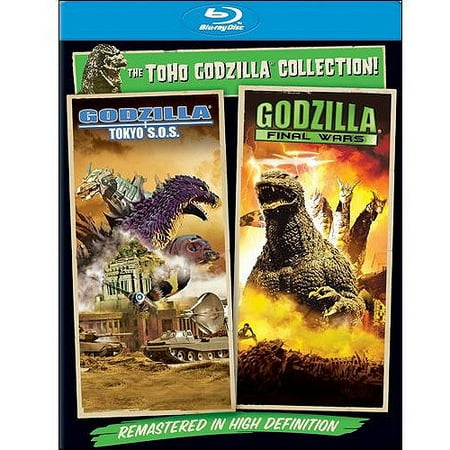

Only bluray that will be hard to get unless you are willing to shell out the cash is Destroy All Monsters(version with commentary track), and maybe the solo vs. Biollante disc.
Slowly collecting all Godzilla movies on Blu-ray. Was on sale for $5 on Amazon.
 ...we off that...
...we off that...



What you on?Blu Ray......we off that...
What you on?
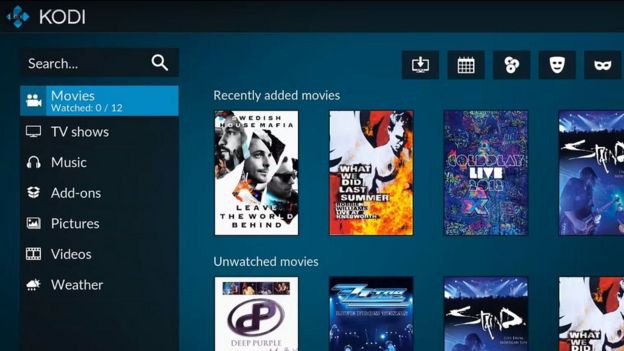
That's cool and all but as great as streaming is, physical discs still look better. Plus we onto UHD discs now
+
G-Technology G-DRIVE 10 TB External HDD - GDREU3G1PB100001BDB - USB 3.0 - 7,200 rpm
I can watch movies for the next 10 years straight.....all hd 1080 quality breh........and It goes whereever I go........takes a about an hour to load, but once it does I got access to what ever
